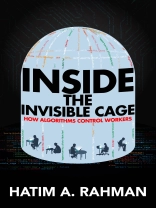In a world increasingly run by algorithms and artificial intelligence, Hatim Rahman traces how organizations are using algorithms to control workers in an “invisible cage.”
Inside the Invisible Cage uses unique longitudinal data to investigate how digital labor platforms use algorithms to dictate the actions of high-skilled workers by determining accepted behaviors, work opportunities, and even success. As Hatim Rahman explains, employers can use algorithms to shift rules and guidelines without notice, explanation, or recourse for workers. The invisible cage signals a profound shift in the way markets and organizations categorize and ultimately control people.
Unlike previous forms of labor control, the invisible cage is ubiquitous, yet it is also opaque and shifting, which makes breaking free from it difficult for workers. This book traces how the invisible cage was developed over time and the implications it has for the spread of new technology, such as generative artificial intelligence.
Inside the Invisible Cage also provides organizations, workers, and policymakers with insights on how to ensure the future of work has truly equitable, mutually beneficial outcomes.
Mục lục
Contents
List of Figure and Tables
Acknowledgments
1 Introduction
2 A New Labor Market Paradigm
3 Ratings: The Driving Force of Algorithmic Control on Talent Finder
4 Laying the Foundations of the Invisible Cage
5 Inside the Invisible Cage
6 The Cascading Consequences of Living Inside the Invisible Cage
7 Reputational Interdependence: Why Workers Remain Inside the Invisible Cage
8 Implications for Theory and Practice
9 The Future of Control in the Age of Algorithms
Methodological Appendix
Notes
References
Index
Giới thiệu về tác giả
Hatim A. Rahman is an award-winning assistant professor at Northwestern University’s Kellogg School of Management.












